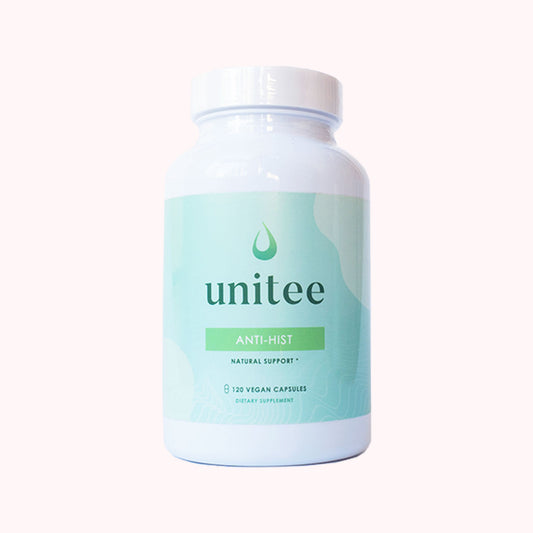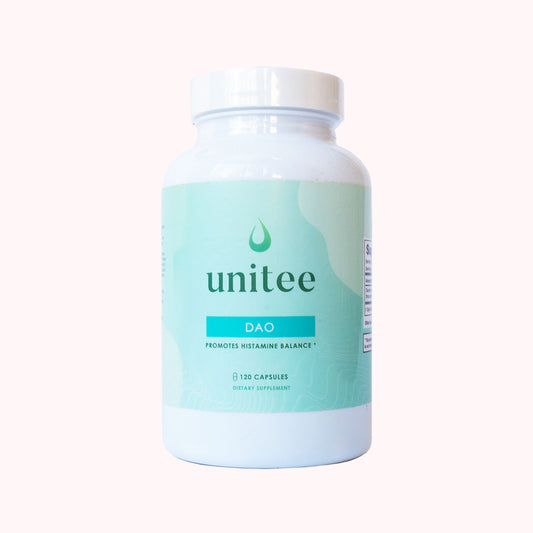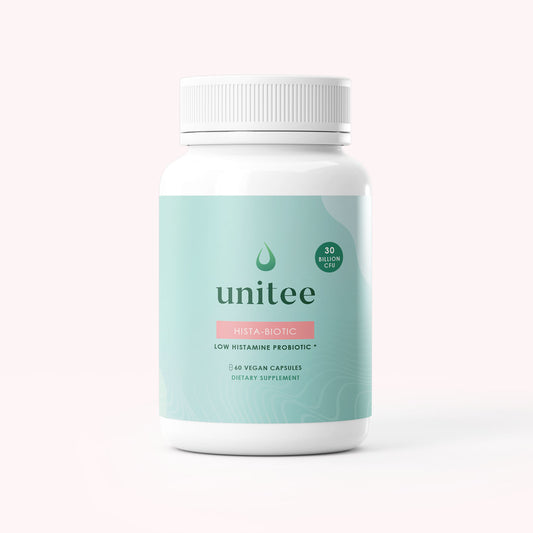There’s no question that food can affect your tolerance to histamine.
There is, however, a question about what exactly is in the food you eat that leads to a poorer tolerance of its amine content.
Here’s how changes in agricultural practices may have contributed to a rising incidence of histamine intolerance...
Histamine and Glyphosate: It’s Not Always the Food Itself
Histamine, as you may very well already know, is called a biogenic amine (1). Basically, that simply means it’s a compound with one or more amine groups, which are chemical compounds that are formed as a result of amino acids being broken down.
Other biogenic amines are cadaverine and putrescine, which are foul-smelling amines that are associated with the breakdown of tissue in living organisms. Think about the stench of fish as it stands out in the sun. This is, in part, due to the release of these two compounds.
Now, what do they have to do with histamine?
Well, in the body, if there are increased levels, they compete with histamine for breakdown. While less well-researched, the detrimental effects of cadaverine and putrescine may be considered to be greater than those of histamine, as they can cause an acute state of life-threatening symptoms (2,3).
If you’ve ever had food poisoning, in particular, having landed up in hospital with an extreme reaction to something you’ve eaten, you’ll know all too well what this feels like. When even small amounts of cadaverine and putrescine are ingested, for example, if you were to go out to enjoy a seafood dish predominantly made up of shellfish, and just a portion of it was underdone, it can have serious consequences.
Not only can it cause almost immediate anaphylaxis - a life-threatening allergic reaction - it can make you extremely and violently ill. Of course, increased histamine ingestion with fish can also bring about these types of symptoms.
In this case, where the condition is called scombroid poisoning, it is associated with increased histamine concentrations in fleshy fish a result of mishandling and improperly following of the cold-chain of manufacture (4).
There is another commonality shared between histamine, cadaverine and putrescine; these compounds all rely on the DAO enzyme to breakdown.
When cadaverine and putrescine are present, DAO prioritizes their breakdown and, therefore, their presence in the body may inadvertently increase the levels and ill-effects of histamine by placing even higher demand on DAO and reducing its capacity to further control histamine (5,6,7).
There’s even evidence to show that cadaverine and putrescine increase histamine’s toxic effects because they facilitate histamine’s transportation rate across the intestine and into the bloodstream.
At this point, you may be wondering how your levels of cadaverine and putrescine increase. You may argue that you don’t eat fish very often, or that you’ve never had an allergic reaction to fish.
Well, the answer may surprise you.
Contributors of Cadaverine and Putrescine As Well as Histamine!
Both cadaverine and putrescine are found in high concentrations in fermented dairy, such as cheese, and high concentrations are also found in fermented sausages, vegetables and fish products (7).
But there’s another source: GMO crops.
GMO Foods and Their Contribution to Histamine Intolerance
Food engineering has crossed paths with agricultural practices, and techniques such as cross breeding of species and gene editing is now common practice in the agricultural industry. The introduction of these techniques has helped to improve agricultural resistance to disease, resistance to pests that may destroy crops, improving the tolerance of plants to weed killers, increasing the time it takes for crops to ripen so that they can be transported over longer distances with less risk of going bad, and allowing the crops to survive in poor weather conditions such as when there is a drought and water may not be as readily available.
It has also been proposed that as technology improves in the space of genetic engineering in agriculture, that food may taste better, and that there’s a possibility of increasing the nutritional value of the food we’re eating.
It all sounds great, and it allows for a higher yield and delivery of staple foods to populations, but for years, there has been a debate about the safety of GMO crops in humans, and it still rages on without a clear indication of the outcome in sight.
What we do know, however, is that GMO crops are more readily sprayed with a particular type of herbicide that contains a compound called glyphosate.
When this weed-killer was first introduced, it not only killed the weeds, but every living plant it came into contact with.
With the introduction of genetic engineering, scientists were able to change how particular genes within plants reacted to the glyphosate and alter them to be able to withstand it - and other pests, for that matter - while the glyphosate continued to kill unwanted species around the desired crops.
With most of the corn and soy used for human consumption across the world now being GMO crops, it is safe to say that these raw ingredients and the products made from them, may very well be contaminated with glyphosate.
Non-GMO crops are also frequently sprayed with this herbicide at the time of harvest, to dry them out faster. Wheat, barley, nuts, peas and oats are some of those on the list. Even organic produce can be contaminated through the environment, and products made from these plant materials may also contain traces of it.
GMOs, Glyphosate and How They Cause Symptoms of Histamine Intolerance
Research published by the Scientific Reports journal in 2016 showed that GMO crops sprayed with glyphosate-containing herbicides contained higher levels of putrescine and cadaverine, in addition to higher amounts of each of their precursors (8).
That being said, if we consider the way putrescine and cadaverine affect the body’s ability to manage histamine, GMO and glyphosate-contamination may be a significant area of histamine toxicity to consider in treatment.
Because they use the DAO enzyme to break down, they leave less available DAO to manage the daily influx of histamines.
More recently, both putrescine and cadaverine have also been found to have direct implications on gut health. And we know how significant gut health is in managing histamine intolerance. Because the gut is lined with mast cells, poor gut health can lead to an increased rate at which mast cells degranulate and release their histamine, flooding the body with more histamine to deal with on top of the effects that cadaverine and putrescine have.
These two compounds have also shown to elicit profound and detrimental toxic effects on the intestinal cells themselve, causing the death of these cells.
Another biogenic amine, called tyramine, presents with similar symptoms to histamine intolerance. Those who react to tyramine can struggle with high blood pressure, migraines, mood disorders, chest pain and shortness of breath. They can also not tolerate foods that are fermented or aged, and they have severe reactions to drinking alcohol. It sounds a lot like histamine intolerance, doesn’t it?
When it comes to histamine itself, has a similar effect to cadaverine and putrescine on the intestinal cells. Histamine has been found to cause programmed cell suicide, or apoptosis, within these cells. So, along with all of the other symptoms that come along with histamine intolerance, and added to that the effects of the other biogenic amines, there’s little wonder why these compounds carry such weight when it comes to health, and an incredibly detrimental toxic potential (9).
...which is why it’s worth trying to figure out why this is happening.
And it also now becomes clear that we need to consider the presence of all biogenic amines in foods and their contribution to histamine intolerance, in order to best understand and control histamine symptoms.
How Can I Begin to Reduce My Histamine Intolerance Symptoms?
Following a low-histamine diet is only one way to reduce the symptoms you’re experiencing from suspected histamine intolerance. If you suspect histamine intolerance but haven't already begun a low histamine diet, it's essential to start this now. Start by following the foods list and guidelines in the free e-Book.
Along with dietary measures and controlling histamine input, it's also possible to enhance histamine breakdown within the body through the histamine-degrading enzyme, DAO (10).
To maximize the effect of DAO and prevent an increased demand on its production, eating organic, non-GMO foods is also advised, as this can reduce the exposure to other biogenic amines, such as cadaverine and putrescine, which take precedence over histamine when it comes to breakdown by DAO (11).
I've written an article on how to increase DAO enzymes naturally, which you can also read for more tips on upping histamine degradation.
Additionally, because raw foods and other - even organic - crops may be contaminated by these compounds, foods should be eaten when they are at their maximum freshness, frozen immediately from fresh, or boiled and eaten immediately to reduce their biogenic amine content.
Histamine intolerance is a complex condition with a number of contributing issues that may be underlying its development.
And, although often forgotten, one of those underlying factors that needs to be considered is the contribution of changes in agricultural practice.
Are you part of the population that may be reacting to these GMO foods and the contamination of glyphosate? It’s definitely worth investigating and taking action against it.
References:
-
Doeun D, Davaatseren M, Chung MS. Biogenic amines in foods. Food Sci Biotechnol. 2017;26(6):1463-1474. Published 2017 Dec 13. doi:10.1007/s10068-017-0239-3
- Del Rio, B., et al. The biogenic amines putrescine and cadaverine show in vitro cytotoxicity at concentrations that can be found in foods. Scientific Reports volume 9, Article number: 120 (2019).
- Ladero, V. et al. Biogenic amines content in Spanish and French natural ciders: Application of qPCR for quantitative detection of biogenic amine-producers. Food Microbiol. 28, 554–561 (2011).
- Hungerford, J. Scombroid poisoning: a review. Toxicon. 2010 Aug 15;56(2):231-43.
- Sahcez-Perez, S., et al. Biogenic Amines in Plant-Origin Foods: Are they Frequently Underestimated in Low-Histamine Diets? Foods. 2018 Dec; 7(12): 205.
- Jarisch R., Wantke F., Raithel M., Hemmer W. Histamine and biogenic amines. In: Jarisch R., editor. Histamine Intolerance. Histamine and Seasickness. Springer; Stuttgart, Germany: 2014. pp. 3–44.
- EFSA Panel on Biological Hazards (BIOHAZ) Scientific opinion on risk based control of biogenic amines formation in fermented foods. EFSA J. 2011;9:2393.
- Mesnage, R., et al. An integrated multi-omics analysis of the NK603 Roundup-tolerant GM maize reveals metabolism disturbances caused by the transformation process. Scientific Reports volume 6, Article number: 37855 (2016).
- Linares, D. M. et al. Comparative analysis of the in vitro cytotoxicity of the dietary biogenic amines tyramine and histamine. Food Chem. 197, 658–663 (2016).
- Schnedl WJ, Schenk M, Lackner S, Enko D, Mangge H, Forster F. Diamine oxidase supplementation improves symptoms in patients with histamine intolerance. Food Sci Biotechnol. 2019;28(6):1779-1784. Published 2019 May 24. doi:10.1007/s10068-019-00627-3
- Sánchez-Pérez S, Comas-Basté O, Costa-Catala J, Iduriaga-Platero I, Veciana-Nogués MT, Vidal-Carou MC and Latorre-Moratalla ML (2022) The Rate of Histamine Degradation by Diamine Oxidase Is Compromised by Other Biogenic Amines. Front. Nutr. 9:897028. doi: 10.3389/fnut.2022.897028

Anita Tee
My name is Anita Tee. I'm a nutritional scientist who specializes in histamine intolerance. I hold a Master of Science in Personalized Nutrition and a Bachelor of Science in Human Biology and Psychology. For the past ten years, I have used my experience in nutritional and medical health sciences to create a scientifically backed, natural approach to healthcare that relies 100% on evidence-based research. As I previously suffered from - and overcame - histamine intolerance, my focus is to increase recognition and expand the available resources and protocols available for resolving this particular disorder. To date, I have helped over 4,000 individuals fully resolve or better manage their histamine intolerance symptoms.







